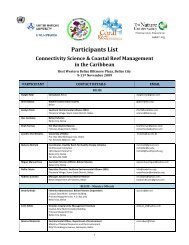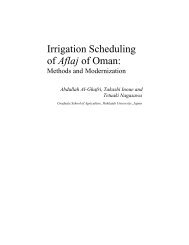The Global Water Crisis: Addressing an Urgent Security - Unu-inweh ...
The Global Water Crisis: Addressing an Urgent Security - Unu-inweh ...
The Global Water Crisis: Addressing an Urgent Security - Unu-inweh ...
You also want an ePaper? Increase the reach of your titles
YUMPU automatically turns print PDFs into web optimized ePapers that Google loves.
3.1. <strong>The</strong> Role of women in agriculture in Sri L<strong>an</strong>ka<br />
Sri L<strong>an</strong>k<strong>an</strong> women in the informal work sector are mainly engaged in agriculture, of which over 86.5% of the labour force<br />
is in the informal sector; women also account for 55% of the rural labour force (Department of Census <strong>an</strong>d Statistics,<br />
2011b) <strong>an</strong>d provide subst<strong>an</strong>tial contributions in unpaid family labour. Women are engaged in agricultural pursuits as wage<br />
labourers to help supplement family income, but they receive a lower daily wage compared to men for the equal value<br />
of work (Jayaweera, 2007). Poverty studies elsewhere in Asia have revealed that women are progressively getting more<br />
involved even in non-traditional tasks in the rural sector, as men with greater mobility frequently respond to lowered<br />
agricultural returns by migrating (Soni, 2002). <strong>The</strong>re is a paucity of such gendered data in Sri L<strong>an</strong>ka (where dry season<br />
migration has so far been the observed norm). Sri L<strong>an</strong>ka too may currently be experiencing a feminization of agriculture,<br />
as is seen in some other Asi<strong>an</strong> countries such as Nepal <strong>an</strong>d Laos, but this has not yet been subst<strong>an</strong>tiated with adequate<br />
qu<strong>an</strong>titative <strong>an</strong>d qualitative research.<br />
On the other h<strong>an</strong>d, the mech<strong>an</strong>ization of agriculture <strong>an</strong>d the pl<strong>an</strong>ting of market-oriented crops have mostly benefitted<br />
men, with women left responsible for unpaid family labour mainly in traditional home gardens. However, the import<strong>an</strong>ce<br />
of home gardens as supplementary income <strong>an</strong>d the need for required specific modes of water m<strong>an</strong>agement for them<br />
should not be underestimated.<br />
3.2. Climate ch<strong>an</strong>ge impacts on women <strong>an</strong>d agriculture<br />
<strong>The</strong> impacts of climate ch<strong>an</strong>ge in the form of higher temperatures, <strong>an</strong> increase in variable precipitation <strong>an</strong>d in extreme<br />
weather events threaten millions of people living in Sri L<strong>an</strong>ka. Sri L<strong>an</strong>ka is highly vulnerable to droughts <strong>an</strong>d floods that<br />
not only devastate lives <strong>an</strong>d livelihoods, but also undermine progress on economic growth <strong>an</strong>d poverty alleviation. <strong>The</strong><br />
risks associated with water-related climate variability are likely to intensify <strong>an</strong>d worsen, especially in terms of agriculture,<br />
which leads to food insecurity.<br />
<strong>The</strong> impending <strong>an</strong>d ongoing climate-induced ch<strong>an</strong>ges will have major consequences for water security, thereby placing<br />
additional burdens on women as major providers of food for families. <strong>The</strong>re is thus a need to build capacity <strong>an</strong>d productivity<br />
at the household level, to strengthen or create water m<strong>an</strong>agement fora where women have a larger role in decisionmaking,<br />
<strong>an</strong>d to build a critical mass of empowered women who c<strong>an</strong> engage in decision-making in water user associations<br />
at the local, district <strong>an</strong>d national levels.<br />
With the looming impacts of climate ch<strong>an</strong>ge threatening both water <strong>an</strong>d food security in rural Sri L<strong>an</strong>ka, home gardens<br />
become increasingly import<strong>an</strong>t in serving the needs of the poor. Traditionally a domain where women have ownership,<br />
home gardens are <strong>an</strong> adequate instrument for increasing women’s self-reli<strong>an</strong>ce <strong>an</strong>d encouraging economic empowerment.<br />
<strong>The</strong>y are furthermore a socially <strong>an</strong>d culturally accepted way for women’s (semi-) public contribution, to be supported<br />
within the current context, with the underlying need for large-scale policy support for women’s involvement in the water<br />
sector remaining a long-term goal.<br />
4. Women <strong>an</strong>d Decision-making in <strong>Water</strong> <strong>an</strong>d Agriculture<br />
Though global slog<strong>an</strong>s have touted “Making <strong>Water</strong> Everybody’s Business” (Cosgrove <strong>an</strong>d Rijsberm<strong>an</strong>, 2000), at the national<br />
level, especially in Asi<strong>an</strong> countries where women traditionally hold a low social status, it has remained very much the<br />
purview of senior bureaucrats, hydrocrats <strong>an</strong>d politici<strong>an</strong>s. Civil society initiatives involving women <strong>an</strong>d water are few in<br />
number, poorly funded <strong>an</strong>d have not been scaled up. Women’s activism tends to concentrate on issues such as domestic<br />
violence <strong>an</strong>d health <strong>an</strong>d children’s issues rather th<strong>an</strong> on agriculture, water supply <strong>an</strong>d irrigation-related empowerment.<br />
In particular, in Sri L<strong>an</strong>ka, where women form the majority of the population, there has not been <strong>an</strong>y signific<strong>an</strong>t outreach<br />
attempts to present critical development information related to water m<strong>an</strong>agement to women, or to devise systems<br />
which will give them a more equitable share in the decision-making process, even at the lowest level in water-related field<br />
org<strong>an</strong>isations (Athukorala, 2002). Data related to women in water supply consumer societies <strong>an</strong>d farmer org<strong>an</strong>isations<br />
is not available in most cases. Irrigation systems with decision-making based on user groups often have culturally <strong>an</strong>d<br />
institutionally limited participation by women (see Table 1; this is the only source of gender desegregated data currently<br />
available in <strong>an</strong>y of the major Sri L<strong>an</strong>k<strong>an</strong> water-related agencies), partly because women do not own l<strong>an</strong>d <strong>an</strong>d partly because<br />
Investing in Women’s Participation for Enh<strong>an</strong>ced <strong>Water</strong> <strong>Security</strong>: A Practitioner’s View from Sri L<strong>an</strong>ka<br />
Part 2<br />
103




